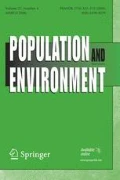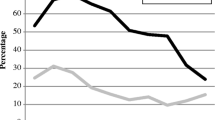Abstract
Existing research inadequately explains the factors that drive temporary internal migration in China. Using data for 2005 drawn from 1,903 households in 43 rural villages, we calculate binomial and multinomial logit (BL, MNL) models of probabilities that an adult belongs to one of three categories of worker—on-farm, off-farm, or temporary migrant—as a function of individual and household characteristics. We control for village fixed effects, paying close attention to male/female differences. Nearly all coefficients—even for village dummies—vary significantly by sex. For two variables—age and schooling—the relationships are non-linear. There is an optimal age and amount of schooling that maximizes the probability that a worker will be employed away from the family farm. For schooling, this is low, suggesting that educated workers are underemployed. This might indicate that schooling beyond primary grades is poor quality, or at least inappropriate for the job market.









Similar content being viewed by others
Notes
The exception is Xia and Simmons (2004), who in lieu of a single gender dummy, include three dummy variables: Single male, single female, and married male, but no interaction terms.
The careful reader might calculate that this leaves more than 200 households without a head. The heads are lacking only because we excluded all individuals 60 years of age and older from our sample. Many of these excluded individuals head a household.
Yang and Guo (1999) estimate separate BL regressions for men and for women. With only individual/household variables, the pseudo R2 is 0.0266 for the men’s regressions and 0.1601 for the women’s. Adding four village variables (distance to a city, per capita income, population density, population growth) raises the pseudo R2 to 0.0856 for men and 0.1997 for women. The increase is greater for men than for women, but this suggests only that the four coefficients in a joint test are significant at a higher level in the men’s regression than in the women’s. One cannot conclude from this that village fixed effects are “larger” for men than for women, any more than one can conclude from looking only at t statistics that a coefficient is quantitatively important. Small coefficients, after all, can have large t statistics.
The turning point of each odds ratio can be calculated by setting the derivative of the logit equation with respect to AGE equal to zero and solving for AGE. For male off-farm work, for example, dz 1 /d AGE = 0.381 − 2*0.00463AGE, which equals zero when AGE = 0.381/0.00926, which is approximately 41 years.
Xia and Simmons (2004) rely on the variables experience and experience squared rather than age and age squared. They define experience as the number of years a person has lived following completion of his or her schooling. The other four MNL studies use the variables age and age squared.
“Both low- and high-skilled individuals are more likely to migrate but usually for different reasons: “surplus” low-skilled individuals have strong incentives to move to the city in search of a manual job they may not find in the rural area, while “scarce” educated workers may find that their human capital is better rewarded in cities than in rural areas” (Lall et al. 2006: 4).
References
Cameron, A. C., & Trivedi, P. K. (2005). Microeconometrics: Methods and applications. Cambridge: Cambridge University Press.
Chan, K. W. (2009). The Chinese hukou system at fifty. Eurasian Geography and Economics, 50(2), 197–221.
Chen, G., & Hamori, S. (2009). Solution to the dilemma of the migrant labor shortage and the rural labor surplus in China. China and World Economy, 17(4), 53–71.
Deininger, K., & Jin, S. (2007). Land rental markets in the process of rural structural transformation: Productivity and equity impacts in China. Policy research working paper 4454. Washington, DC: The World Bank.
Démurger, S., Fournier, M., & Yang, W. (2009). Rural households’ decisions towards income diversification: Evidence from a township in northern China. GATE Working Paper, 09-23 (November). Écully: Groupe d’Analyse et de Théorie Économique.
Du, Y., Park, A. F., & Wang, S. (2005). Migration and rural poverty in China. Journal of Comparative Economics, 33(4), 688–709.
Gu, W. (2005). 20 years of the rural household survey. Available at: http://www.china.org.cn/archive/2005-09/29/content_1143917.htm. Accessed 1 March 2010.
Katz, E., & Stark, O. (1987). International migration under asymmetric information. Economic Journal, 387(September), 718–726.
Knight, J., & Song, L. (2003). Chinese peasant choices: Migration, rural industry or farming. Oxford Development Studies, 31(2), 123–147.
Knight, J., Li, S., & Deng, Q. (2010). Education and the poverty trap in rural China: Closing the trap. Oxford Development Studies, 38(1), 1–24.
Lall, S. V., Selod, H., & Shalizi, Z. (2006). Rural-urban migration in developing countries: A survey of theoretical predictions and empirical findings. Policy research working paper 3915. Washington, DC: The World Bank.
Lewis, W. A. (1954). The theory of economic growth. London: George Allen and Unwin.
Liu, Z. (2008). Human capital externalities and rural—urban migration: evidence from rural China. China Economic Review, 19(3), 521–535.
National Bureau of Statistics. (2006). China statistical yearbook. Beijing: China Statistics Press.
Rozelle, S., Brandt, L., Li, G., & Huang, J. (2002). Land rights in China: facts, fictions, and issues. China Journal, 47(January), 67–69.
Shi, X., Heerink, N., & Qu, F. (2007). Choices between different off-farm employment sub-categories: An empirical analysis for Jiangxi Province. China Economic Review, 18(4), 438–445.
Stark, O., & Taylor, J. E. (1991). Migration incentives, migration types: The role of relative deprivation. Economic Journal, 101(September), 1163–1178.
Tao, R., & Xu, Z. (2007). Urbanization, rural land system and social security for migrants in China. Journal of Development Studies, 43(7), 1301–1320.
Wu, Z. (2010). Self-selection and earnings of migrants: Evidence from rural China. Asian Economic Journal, 24(1), 23–44.
Xia, Q., & Simmons, C. (2004). The determinants of labour-time allocation between farm and off-farm work in rural China: The case of Liaoning Province. Journal of Chinese Economic and Business Studies, 2(2), 169–184.
Xinhua News Agency (2008). China gives green light for farmers to subcontract farmland. China Daily, 28 October, http://www.chinadaily.com.cn/bizchina/2008-10/24/content_7138734.htm.
Yang, X., & Guo, F. (1999). Gender differences in determinants of temporary labor migration in China: A multilevel analysis. International Migration Review, 33(4), 929–953.
Zhang, L. (2009). China’s informal urbanization: Conceptualization, dimensions and implications. Post-Communist Economies, 21(2), 203–225.
Zhang, L., Huang, J., & Rozelle, S. (2002). Employment, emerging labor markets, and the role of education in rural China. China Economic Review, 13(2–3), 313–328.
Zhao, Y. (1997). Zhongguo nongcun laodongli liudong ji jiaoyu zai qizhong de zuoyong [Rural labor migration and the role of education]. Jingji yanjiu, 2, 37–42.
Zhao, Y. (1999). Labor migration and earnings differences: The case of rural China. Economic Development and Cultural Change, 47(4), 767–782.
Acknowledgments
The authors would like to thank two anonymous referees for helpful suggestions on an earlier draft.
Author information
Authors and Affiliations
Corresponding author
Rights and permissions
About this article
Cite this article
Willmore, L., Cao, GY. & Xin, LJ. Determinants of off-farm work and temporary migration in China. Popul Environ 33, 161–185 (2012). https://doi.org/10.1007/s11111-011-0135-3
Published:
Issue Date:
DOI: https://doi.org/10.1007/s11111-011-0135-3



